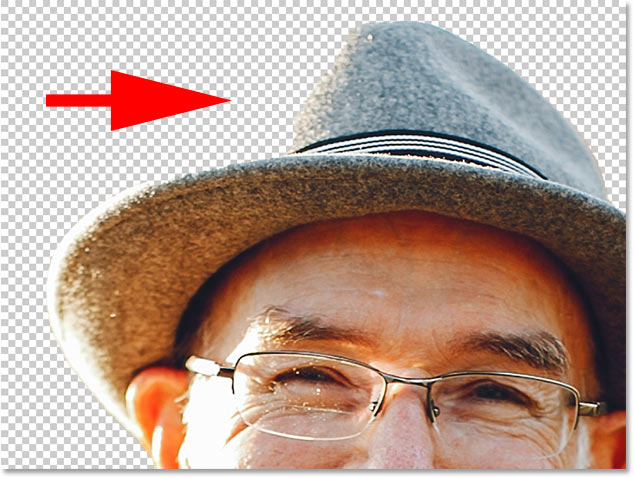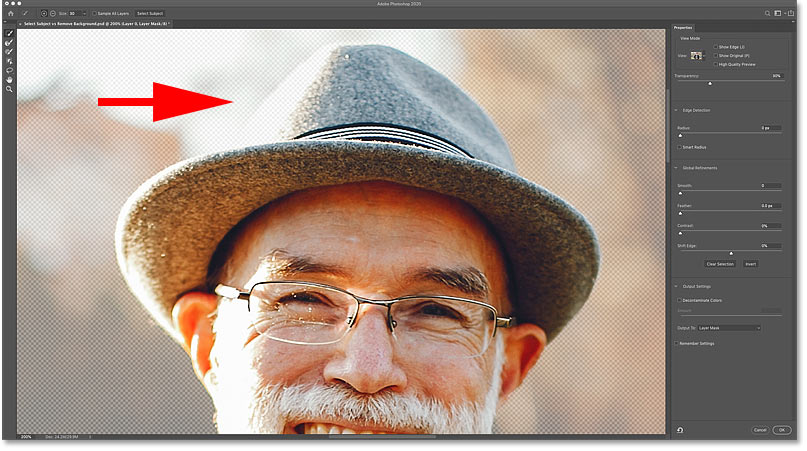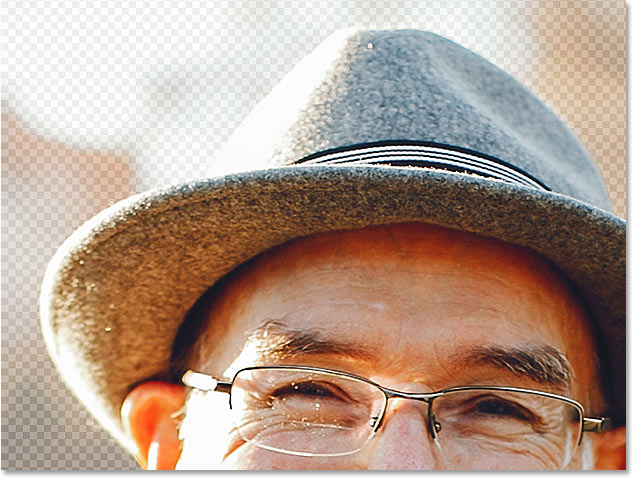
Select Subject vs Remove Background in Photoshop

Learn how to use the Select Subject and Remove Background commands in Photoshop CC 2020 to quickly remove the background from your photos, and which one gives you the best results!
Download PDF: Select Subject vs Remove Background
Photoshop now includes not one but two commands that can automatically select the main subject of your image and isolate it from its background. One of these commands is Select Subject, first introduced in CC 2018 and now greatly improved in CC 2020. And the other is Remove Background which is brand new as of CC 2020. Both Select Subject and Remove Background will analyze your image, look for the main subject, and select it. And both are fully automatic. Simply choose the command and Photoshop does all the work!
So does this mean Photoshop now has two commands that do the same thing? While they sound similar, there is one important difference between them. Select Subject draws the selection and then leaves it up to you to decide what to do with that selection. In other words, Photoshop says, "Okay, here's your selection. Now do whatever you want with it." But Remove Background takes it a step further. It draws the same selection as Select Subject but then goes ahead and actually removes the background.
In this tutorial, we'll look at how you can use either of these commands to remove the background from your photo, and why Select Subject may actually be easier even if Remove Background is faster. I'll also show you how the new Object Selection Tool can be used to fix any problem areas, including how to use the tool in Photoshop's Select and Mask workspace.
To follow along, you'll need Photoshop 2020 or later. You can get the latest Photoshop version here.
Let's get started!
The document setup
For this tutorial, I'll use this image from Adobe Stock. We'll start by learning how to remove the man from the background using Select Subject, and then we'll compare the results with Remove Background:

Where to find Select Subject and Remove Background
Select Subject and Remove Background may be similar in what they do, but the way we access them in Photoshop is different. That's because there are many ways to choose Select Subject, but only one place you'll find Remove Background. And even then, it won't always be there.
The Properties panel
One place you'll find the Select Subject command, and the only place you'll find Remove Background, is in Photoshop's Properties panel. But for either of these commands to appear in the Properties panel, you first need to have a standard pixel layer selected in the Layers panel.
Notice in my Layers panel that the image is currently sitting on the Background layer. And while the Background layer is technically a pixel layer, it's not the same as a standard pixel layer. Background layers are really just the background of the document:

And if we look in the Properties panel, Select Subject and Remove Background are both missing. Normally they would appear under the Quick Actions menu. But because I don't have a standard pixel layer selected, neither command is available:

Converting the Background layer to a standard layer
To fix that, simply convert the Background layer into a standard pixel layer by clicking the lock icon:

Photoshop renames the layer from "Background" to "Layer 0", which means it's now a standard layer:

And in the Properties panel, a Select Subject button and a Remove Background button appear:

How to use Select Subject to remove a background
So now that the image is on a standard pixel layer, I'll try selecting the man and removing the background using Photoshop's Select Subject command. Then we'll try the same thing using the Remove Background command so we can compare the results.
Applying the Select Subject command
Using Select Subject is easy. Just click the Select Subject button:

Photoshop analyzes the image looking for the subject, and after a few moments, a selection outline appears.
The result will depend on your image. But in my case, the initial selection looks pretty good. The outline appears only around the man and nothing in the background was included:

Looking for problems with the selection
However, if I zoom in for a closer look at the initial selection, we see that Select Subject missed part of the man's hat. The increased brightness in that area from the sun shining on it is probably what threw it off:

Using the Object Selection Tool to add the missing area
But even though the selection isn't perfect, this does not mean that Select Subject didn't work. It still did most of the job for us and gave us a great starting point. And Photoshop includes lots of other selection tools we can use to fix any problems. In this case, the Object Selection Tool (new as of CC 2020) will work great.
I'll choose the Object Selection Tool from the toolbar:

Then in the Options Bar, I'll change the tool's Mode from Rectangle to Lasso so I can draw a freehand selection around the missing area:

Since I want to add the missing area to the existing selection, I'll press the Shift key on my keyboard. And then with the key held down, I'll drag an outline around the missing part of the hat. There's no need to be precise. Just stay close but outside the area you need to add:

When I release my mouse button, Photoshop analyzes the area inside the outline looking for anything that should be included in the selection. And after a few moments, the missing part of the hat is added.
You can also subtract areas from the selection using the Object Selection Tool by pressing and holding the Alt (Win) / Option (Mac) key on your keyboard as you drag around them:

The final Select Subject result
And now, using a combination of Select Subject and the Object Selection Tool, the selection is looking good:

How to remove the background
Of course, if our goal was to remove the background, then we're still not done. Even though Select Subject did draw a selection around the man in the photo, it did nothing to remove him from the background. So if we want to remove the background, we need to do that ourselves. And one way would be to convert the selection into a layer mask.
In the Layers panel, click the Add Layer Mask icon:

And just like, the background disappears:

Why did the background disappear? It's because Photoshop converted our selection into a layer mask, as shown by the layer mask thumbnail in the Layers panel. The white area on the mask is our subject which remains visible, while the black areas surrounding him are hidden from view.
And that's at least one way to remove your subject from the background using the Select Subject command:

How to use the Remove Background command
So far, we've seen that Select Subject automatically selects the main subject in a photo, but removing the background is an extra step we need to do ourselves. Next, let's see what happens when we try the Remove Background command.
Restoring the original photo
First, I'll revert my image back to its original state by going up to the File menu in the Menu Bar and choosing Revert:

This restores the entire image:

Converting the Background layer to a standard layer
It also restores the Background layer in the Layers panel which prevents us from seeing the Select Subject and Remove Background buttons in the Properties panel. So to bring them back, I'll once again unlock the Background layer by clicking its lock icon:

Applying the Remove Background command
Using Remove Background is just as easy as using Select Subject. Simply click the Remove Background button in the Properties panel:

Photoshop again analyzes the image looking for the main subject, and after a few moments, we see the result.
But this time, instead of just placing a selection outline around the man in the photo, the Remove Background command went further and actually removed the background:

How Remove Background works
The way Remove Background works is that it actually uses Select Subject to detect and select your subject, and then it takes that selection and converts it to a layer mask automatically. So Remove Background is not really a separate command. It's more like an extension, or an extended version, of Select Subject.
In the Layers panel, we see the layer mask that was automatically created by the Remove Background command:

The problem with Remove Background
At this point, you may be asking, "If Remove Background does all the work for us, and Select Subject only does half the job, why would anyone use Select Subject to remove a background? Why not just use Remove Background?" And this is where the problem with the Remove Background command comes in.
Remember back when Select Subject missed part of the man's hat? Well, if we zoom in on the image after running the Remove Background command, guess what? Remove Background missed it, too:

And here's the problem. With Select Subject, it was easy to add the missing area to the selection before the background was removed using the Object Select Tool. But how do we do that now when the background has already been removed and the area is still missing?
Fortunately, the solution is easy. To fix problems with a layer mask, we can use Photoshop's Select and Mask workspace. And as of Photoshop CC 2020, the Select and Mask workspace includes the same Object Selection Tool we used earlier!
Using Select and Mask to add the missing area
Here's how you could use the Object Selection Tool in the Select and Mask workspace to restore a missing part of the image after applying the Remove Background command.
Step 1: Select the layer mask
First, in the Layers panel, make sure the layer mask thumbnail is selected:

Step 2: Open Select and Mask
Then in the Properties panel, click the Select and Mask button:

The image opens in Photoshop's Select and Mask workspace (or "taskspace" as Adobe likes to call it):

Step 3: Set the View to Onion Skin and lower the transparency
To view the entire image so you can see the parts that are missing, set the View Mode in the upper right to Onion Skin:

And then lower the Transparency to around 30 percent:

This allows the areas that are hidden by the layer mask to be faintly visible. And if I zoom in on the man's hat, we can now see the part that's missing:

Step 4: Choose the Object Selection Tool
In the toolbar along the left of the workspace, choose the Object Selection Tool:

Step 5: Set the Mode to Lasso
And in the Select and Mask Options Bar, set the tool's Mode to Lasso so you can draw a freehand selection:

Step 6: Draw an outline around the missing area
Then simply click and drag an outline around the missing part of the image.
There's no need to hold Shift as you drag this time because the Object Selection Tool in the Select and Mask workspace defaults to the Add to Selection mode. But if you need to remove an area from the selection, then you still need to hold Alt (Win) / Option (Mac) as you drag.
Here I'm dragging around the missing part of the hat:

Release your mouse button, and the missing area is added. We know it was added because the area becomes fully visible while the rest of the background (the area still hidden by the mask) remains partially transparent:

Step 7: Output the selection as a layer mask
Finally, in the lower right of the Select and Mask workspace, set the Output To option to Layer Mask. This will replace the existing layer mask with the new one that now includes the missing area.
You could also choose New Layer with Layer Mask if you want the original version and the new version to be on separate layers, but it's easier to just to overwrite the original since we really don't need it:

Step 8: Close the Select and Mask workspace
Click OK to close the Select and Mask workspace. Back in our document, the missing part of the hat has been restored, and we now have the exact same result that we got by removing the background using the Select Subject command:

Summary: Select Subject vs Remove Background
Both the Select Subject and Remove Background commands in Photoshop CC 2020 can be used to quickly select your subject and remove the background from your photo. The difference between them is that Select Subject requires you to manually remove the background after it draws the selection, whereas Remove Background selects your subject and removes the background with a single click.
Yet while Remove Background is faster, Select Subject makes it easier and more intuitive to find and fix problems with the selection before the background is removed. And since you'll almost always need to refine the selection regardless of which command you choose, Select Subject is usually the better choice.
And there we have it! To learn more about topics I covered briefly in this lesson, check out my complete Select Subject tutorial or my Object Selection Tool tutorial. And to learn how to use other selection tools, see my Photoshop Selection Tools lesson guide.